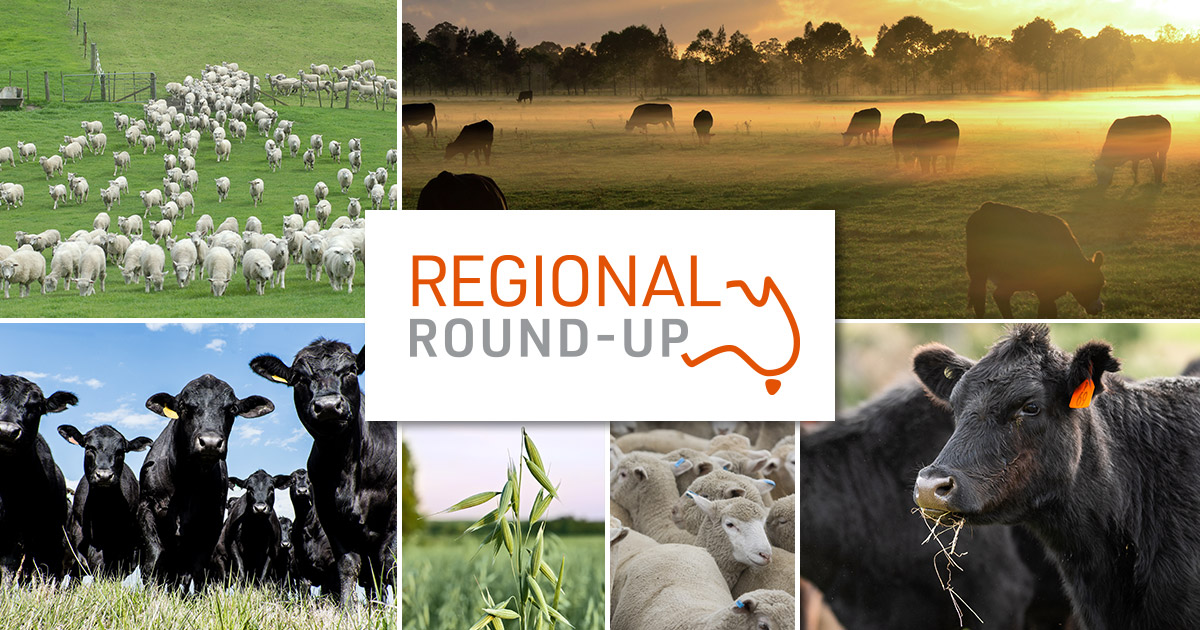Regional Round-Up

Welcome to the third instalment of our monthly regional round-up – StockCo’s state-by-state overview of the latest happenings from the livestock industry across Australia.
 |
National overview – Chris Howie The impact of African swine fever is still very significant and the shortage is creating a product-hole that in turn creates demand. It’s important to remember that, in Australia, we cannot eat all we produce, so like New Zealand we’re at the mercy of the season and – whether we’re talking beef or lamb – world demand for red meat protein is continuing to grow. At present, New South Wales and Queensland have grass, and therefore supply is based on when an animal is ready, rather than a forced sale. However, the South Australia and Victorian season – other than the far south – is dry and powdery, meaning livestock is coming onto the market because of the season as well as the approaching tractor-driving season. This is the normal cycle most years, hence the prices don’t move a lot. Cattle are still holding their own and feeder demand is still very strong – especially for the performance end of the blacks and cattle under assurance programs. Grass contracts are also available till August and September at good rates. I’m a great believer in taking a piece of these grass contracts if you’re going to run cattle on good pasture or crop, with them ideally signed up by mid-to-late July. If you have cattle to sell, irrespective of breed, do your homework on what supply box they fit into and make those buyers aware of what you have. Mutton continues to trade strongly in all states, and the recent cyclone that went walkabout through the south of Western Australia caused considerable damage to farm infrastructure but did deliver much-needed rain that is well-aligned to the winter cropping program. In South Australia and Victoria above the Penola to Horsham line, the season is really starting to bite. Early summer rains destroyed the dry feed and now paddocks are bare and dusty. This in turn has seen a supply of lambs come on which have processor requirements covered into May. Finally, Beef 21 is here and the excitement is palpable. I’ll be attending at the StockCo stand, and would love to have a chat if you find yourself in the vicinity. |
 |
Queensland – Angus Creedon Here in Queensland, it’s starting to cool down and late autumn storms are helping with the winter crop establishment. Plenty of oats and grazing winter crops are being planted on great moisture profiles. Once most of the grass from summer has either frosted off or stopped growing, graziers with forage crops will purchase cattle and we’ll begin to see weaners hit the Queensland market over the next three months.In general, livestock prices have remained firm. Feeder prices haven’t changed for the past four weeks and processor prices have also stayed the same in a bid to level/lower the store price to be more economical. Overall, things are looking great except that the first few frosts of the season will see a decline in protein and energy levels in the grass, meaning producers will need to decide if their current grass levels are enough to take them through to the end of the year. |
 |
NSW – Toby Hammond Although NSW experienced substantial rainfall in early March, only the odd isolated shower has been reported since then. Most central and southern regions have by now experienced intermittent frosts, with residents in some places waking up to consecutive light frosts for an entire week or more. Daytime temperatures have also dropped back to tops of 22 degrees (textbook for autumn), which contributes to the general sense that we’re experiencing much more normal weather patterns than in previous years. Despite the lack of rain recently, farmers have reported that sub-soil moisture levels are still adequate and that the grass is benefiting. Many experts have declared that we’ve now reached the top of the market, which indicates that – without any rain on the horizon – the restocker market could soften. Compared with this time last year, there’s still a distinct price difference across most categories of livestock where values are considered high. There was such strong confidence in the season during the same period in 2020 that the market was gaining momentum each week. At the moment, it’s a different scenario – prices remain strong but stagnant. Store lambs are still bringing $170/hd and well-bred young cattle under 300kg are still attracting prices upwards of $6/kg lwt. Some lamb processors have released forward prices in the early-to-mid $8 mark, and it will be interesting to see what sort of uptake they have on these contracts. |
 |
Victoria – Michael Phelan The Victorian situation is very similar to this time last month. There was no significant rainfall in the western half of the state, and regions that did receive small amounts of rain over the past month (mostly central and eastern Victoria) are looking for follow-up rain to kick on a good early strike of pastures.For breeders in areas where there hasn’t been sufficient rainfall, lambs are hitting the ground onto less than ideal paddocks. Heavy supplementary feeding isn’t ideal because it draws less-attentive mothers away from their lamb to feed, and there’s no substitute for a green pick. In previous seasons, many have pushed lambing into May or even June to ensure there’s green feed on the ground. This isn’t devoid of risks, as it can lead to lambing-down in cold, wet and windy conditions. Autumn breaks on average come two weeks either side of Anzac day, so there is still time but earlier breaks can save graziers a lot of money at this time of year.A flurry of feedlot lambs have entered the livestock market just as many mixed farmers turn their attention to getting their crops in the ground, causing prices to ease. Forward contracts for processors are now out for May and June and show a slight uptick, and the commitment processors get at their contract offerings will impact where spot market prices go between now and the end of June. Cattle prices remain strong, although there are signs things are hitting the rev limiter. Many are choosing to sit out of the market for the moment – particularly when buying weaner cattle – but persistent rain in NSW and Queensland will help keep the Australian fundamentals strong for a while yet and opportunities are still there for buyers. Finally, I attended the “Beef It Up” expo at Corryong last week, where independent livestock analyst Simon Quilty spoke about world fundamentals for beef and lamb. Signs are looking good in terms of demand for both products. This is largely due to the fact that the US in particular is vaccinating its population at break-neck speed, which is restoring confidence in food outlets. It even looks as though the cruise ship sector may bounce back in time. |


